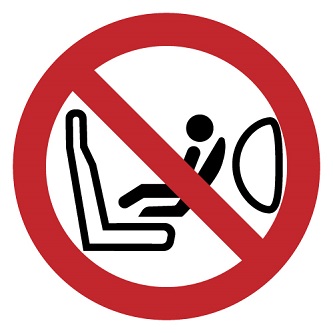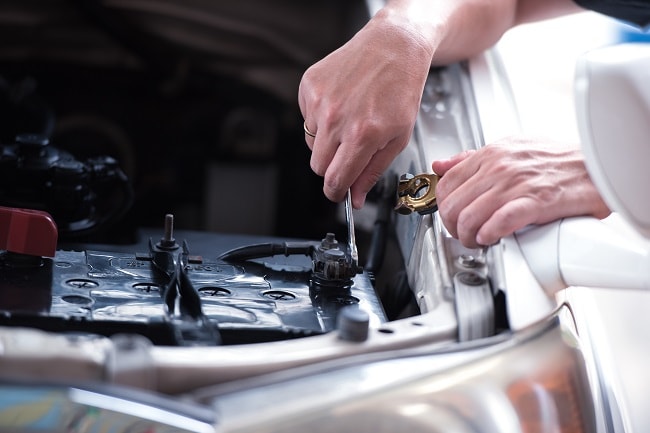
Car manufacturers have been actively working on this for several decades, making the probability heavier Reduce injuries from car accidents. One of the best innovations in this area are airbags, which have already saved millions of lives. According to the US Transportation Safety Institute (IIHS), airbags can reduce the chance of death in an accident by a third and sometimes even a half. On the other hand, they can be dangerous if used improperly. In this article we describe how they work, how to use them and in which cases to disable them.
Contents
8 interesting things about airbags
- The first airbag patents were filed simultaneously in 1951 by Walter Linderer in The United Kingdom and John Hetrik in the USA. The designed devices were inflated with compressed air. Due to the extremely slow activation, i.e. poor performance, this innovation did not catch on at first.
- In 1963, the Japanese Yasuzaburou Kobori decided to use a propellant to inflate the cushion instead of compressed air. However, due to Japanese fire safety laws, Kobori's innovation encountered many limitations, which is why research in this area was discontinued.
- In 1968, inventor Allen Breed presented the first airbag impact sensor that enabled the system to activate automatically .
- The first production vehicle with a front airbag was the American Oldsmobile Toronado in 1973. In Europe, the airbag was introduced in 1980 in the Mercedes-Benz S-Class sedans.
- Over the years, many well-known car manufacturers have worked on the development of this technology:
- In 1994, Volvo began installing side airbags in their vehicles. These airbags protect the pelvis, chest and abdomen and prevent sharp objects from entering the passenger compartment.
- In 1996, the Korean automobile brand KIA began installing knee airbags in its cars. These airbags are designed to better protect the lower extremities.
- In 1998, Toyota and Volvo used curtain airbags to prevent head injuries in side impacts and rollovers. In addition to their main functions, the devices developed by these companies prevented broken glass from entering the passenger compartment and passengers from being ejected.
- In 2009, Toyota introduced another innovation: the so-called center airbag. Its function is to protect the driver and passengers from injuries that can be caused, for example, by collisions between occupants.
- In 2012, Volvo developed an airbag to protect pedestrians. The so-called pedestrian airbag is installed under the bonnet and inflates in the area between the bonnet and the windshield in the event of a collision to protect the pedestrian's head.
- Also in 2012, Ford presented seat belts with integrated inflatable elements in Europe. This system distributes the impact force more evenly to minimize the likelihood of serious injury, especially to children.
- There can be as many as 14 inflatable devices in a car today.

- As is known, the airbag remains in the folded state for a long time. To prevent the folded layers from sticking together, manufacturers use talc or starch as a lubricant: these are the substances that can be seen inside the car after the system is activated.
- In general, it takes 0 .01 to 0.05 seconds for an airbag to fully deploy. A human needs more time to blink: on average, the blink of an eye lasts 0.05 seconds.
9 recommendations from CarTipsandmore for the correct use of airbags
- Always use seat belts. Airbags are not a replacement for seat belts, they are only an additional protection system. Because after deployment, the airbag moves at a speed of 300 km/htowards the driver or the passenger, it is actually possible to suffer serious injuries if the seat belts are not fastened.
- Adjust the seat correctly. The distance between Driver and steering wheel center must be at least 25 cm. This requires moving the seat backwards or tilting the backrest. The owners of older vehicle generations, whose seats are not equipped with a variety of adjustments, can use special pedal extensions to enable a comfortable drive.

- digits Make sure your posture is correct.The driver and passengers must sit in the middle of the seats and lean back. The feet must be on the ground. Never lean against an airbag: high inflation forces and hot gases can cause injury here. It is also forbidden to lean against a window here, especially for children.
- Always make sure that nothing is preventing the deployment of the airbag.Do not use any seat covers: they can otherwise partially or completely block the deployment of the side airbags. Do not store heavy or sharp objects in the door compartments: they may cause injury if the system is activated. For the same reason, you must not have a bag or other objects on your lap.
- Do not install a child seat in the front seat. We recommend that children under the age of 12 travel in the rear seats. In some countries this is required by law. If you need to fit a child seat on the front passenger seat, move the front passenger seat as far back as possible and, if necessary, deactivate the airbag. In most modern cars, deactivation is automatic.

- Pregnant women Women in their last trimester should not refrain from using this technology.Although the risk of injury to the fetus from the airbag is high, the consequences of a collision with the steering column are generally more serious. Properly adjusted and worn seat belts, together with activated airbags, ensure maximum safety. However, in the last stages of pregnancy it is better to avoid driving, especially if you are behind the wheel.
- Do not smoke while behind the wheel. Cigarettes or Electronic cigarettes are not only a source of distraction, they also pose a major risk of fatal injury if the airbag is deployed.

- Monitor the status of the system. The display on the dashboard indicates that the system is working properly. This warning light comes on when the ignition is switched on and then goes off after 5-6 seconds. If the warning light stays on continuously or comes on intermittently while driving, you must contact a workshop for a detailed diagnosis.
- Never remove the cover and do not insert any Repairs in the area of the inflatable devices can be carried out without first disconnecting the electrical connection to the battery. Only disconnecting the battery guarantees protection against the sudden activation of the airbags.

Conclusion
Undoubtedly, airbags are one of the best technological innovations today to protect drivers and passengers from injury in the event of an accident. Despite their obvious advantages, however, they also pose certain dangers, which is why some rules must be strictly observed. By following these rules and using other active and passive safety systems, you can protect yourself and your passengers from the dangers of a variety of unforeseen traffic situations.
